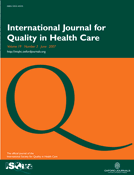-
PDF
- Split View
-
Views
-
Cite
Cite
Claire R Brown, Where are the patients in the quality of health care?, International Journal for Quality in Health Care, Volume 19, Issue 3, June 2007, Pages 125–126, https://doi.org/10.1093/intqhc/mzm009
Close - Share Icon Share
While the achievements of the Organisation for Economic Co-Operation and Development (OECD) Health Care Quality Indicators (HCQI) Project [1] are laudable and enable international comparisons of health care systems in terms of a particular type of quality, it is important to remember that quality is not value neutral. As Donabedian pointed out, 1981, explicit measures of quality carry with them the values of those who have defined the measures, and such measures are amenable to being used as instruments of control [2].
Who defines quality and who measures it are pivotal questions for those who engage in its pursuit. However, it would seem there is little consensus about the meaning or measurement of quality from the stakeholders involved in health. Of greater concern is that, despite the apparent plethora of attempts to gauge patient satisfaction with their health care experiences, there is a worrying downgrading of patients' perspective views of what they feel comprises quality health care.
In most instances quality health care is assumed to occur with quality medical care [3, 4], including in Donabedian's seminal Structure/Process/Outcomes model [5], yet even physicians have a difficult time agreeing on the nature of quality [3]. In general, to the physician, quality health care leads to ‘cure’ [5], measured, somewhat naturally, by patient health outcomes. Many of the available indicators used in the OECD HCQI Project can be classified as patient health outcomes.
It is not only physicians who judge quality by patient health outcomes. To the nurse quality health care is the process that enables recovery [6]. Thus for nurses the process of health care is the site of quality, yet this is largely assessed by patient health outcomes.
Process—what is done—can be more sensitive than outcomes—what happens [7–9], yet patient health outcomes are so intrinsically appealing as measures of quality that often, even when purporting to assess process, outcomes are used as indicators [7, 8]. Furthermore, whether indicators of outcomes or process are used, it is easier to use firm, quantifiable indicators that adds another problem if the nature of quality is not such that it can be easily quantified. The very nature of a project such as the HCQI Project means that, in order to achieve international viability, the indicators used must be of a concrete nature, whether these be indicators of outcomes or indicators of process.
From the above discussion of the centrality of patient health outcomes as indicators of quality, it would seem that the patient is central to concepts of quality health care. The only concern is whether patient health outcomes are central to patient definitions of quality health care and, if not, how much weight is given to that which patients consider defines quality health care from their perspective?
Patient satisfaction questionnaires are plentiful, yet patient satisfaction with health care does not seem to be associated with the effect of care received as high patient satisfaction with the care received can be found even if the desired patient health outcome has not been obtained [10]. The question then becomes what is the nature of the association between patient satisfaction with care, quality of care and patient health outcomes? There is a risk of patient-centred care being downgraded to care that leads to satisfied patients and to patients being sidelined in terms of their views of what constitutes quality health care. If patients are not placing the same weight on patient health outcomes as the rest of the health care community, it may lead to the argument that the same weight does not need to be applied to their definitions of quality, only whether or not they are satisfied?
Patient health outcomes measurement of ‘quality’ means that its measurement is largely independent of patient' perceptions of satisfactory health care [10]. Do patients equate satisfactory health care with quality health care and just use different (unknown) outcome measures or are we not measuring patients' views of quality?
If we are to be confident of delivering health care of the highest quality, we must be confident that we are listening to patients at every step of the quality journey, allowing patients to define the outcomes they desire for their interactions with the health care system and, thus, allowing patients to define quality health care.
What we continually move toward using as indicators of quality tend to relate to the human biology aspects of Lalonde's multi-dimensional model of health [1] rather than any factor in lifestyle or the environment. It is possible that the latter two aspects of health determinants are of more relevance to patients and that outcomes in these areas, although difficult to validly and reliably measure, are of more relevance to what patients see as quality health care.
It is possible that, despite the plethora of satisfaction, needs assessment and quality of care forms collected, the patient is becoming an evermore silent partner in the health care system as their views of quality have largely been sidelined by the number of attempts to determine patient satisfaction with health care. Perhaps the voice of patients is being swamped by patient health outcome driven quality.
It is known that patient health outcomes are not the core of quality from a patient perspective. Perhaps these illusive measures of quality from the patients' perspective are to be found in either the environment or lifestyle aspects of Lalonde's model [1]. These outcomes, whatever they may be, will be difficult to define and hard to measure but they are essential to discover if patients are to be truly involved, on their own terms, in defining quality health care.
This editorial is largely based on a poster presentation given at the 22nd International Conference of the International Society for Quality in Health Care in Vancouver, Canada, October 2005.



